Data Mining Techniques to Optimize a Data Set: UPS Analysis
VerifiedAdded on 2023/01/19
|10
|2037
|93
Report
AI Summary
This report evaluates various data mining techniques to optimize data sets, using United Parcel Service (UPS) as a case study. It begins by defining data mining and its techniques, including the use of Excel Solver for data analysis. The report then analyzes the processes used, comparing data mining techniques employed by UPS with those demonstrated in the example. It explores how UPS leverages big data and data mining for operational improvements, such as tracking patterns and association techniques. Furthermore, it addresses the challenges big data presents, including data security, validation, and integration, as well as the limitations of current data mining techniques. The report also summarizes relevant articles on decision support systems and knowledge-based models, highlighting their relevance to data mining and decision-making processes. Finally, it references key literature on data mining and big data applications.

Evaluate Data Mining Techniques to Optimize a Data Set
Student’s Name
Course Name
Instructor’s Name
University
City and State
Date
Student’s Name
Course Name
Instructor’s Name
University
City and State
Date
Paraphrase This Document
Need a fresh take? Get an instant paraphrase of this document with our AI Paraphraser
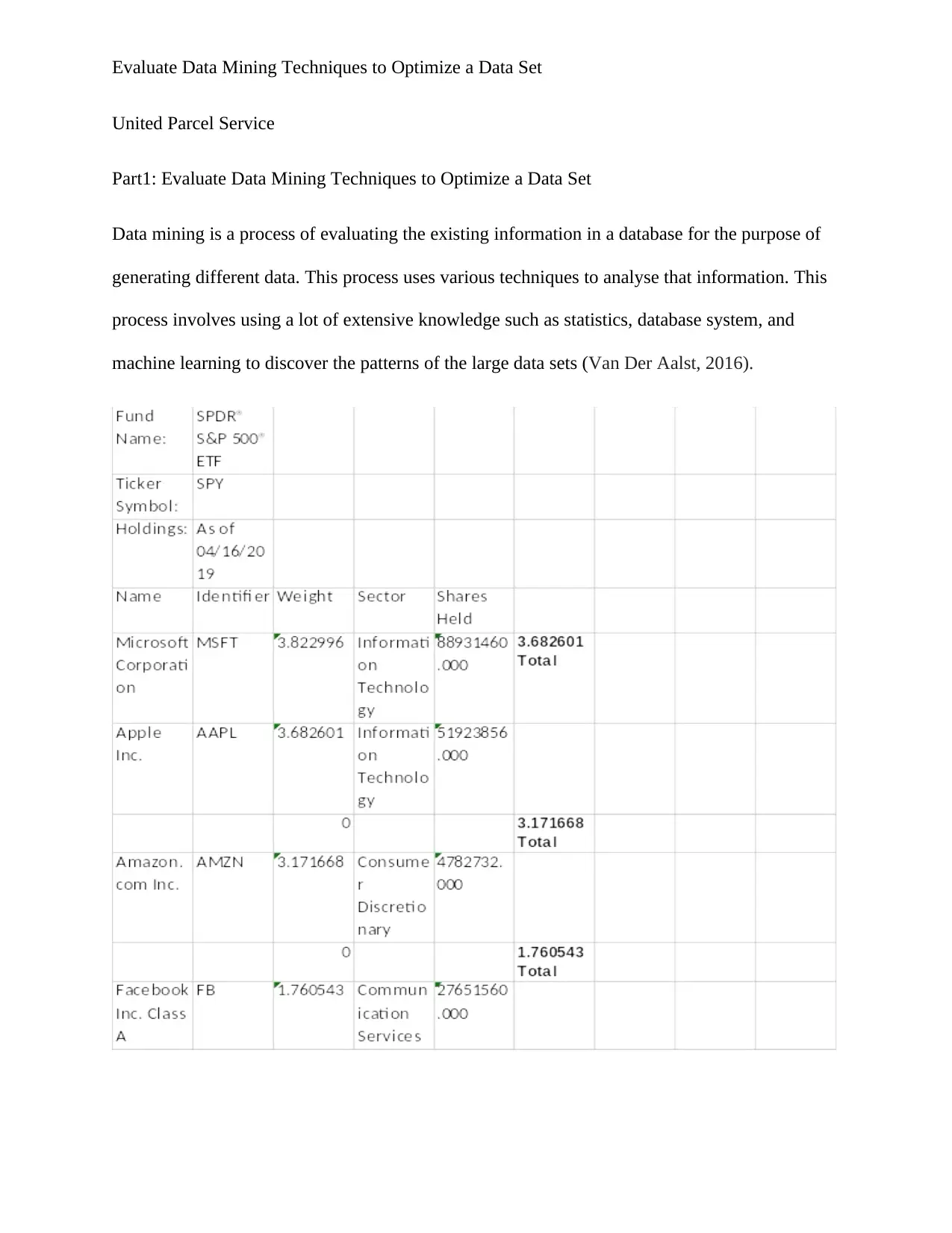
Evaluate Data Mining Techniques to Optimize a Data Set
United Parcel Service
Part1: Evaluate Data Mining Techniques to Optimize a Data Set
Data mining is a process of evaluating the existing information in a database for the purpose of
generating different data. This process uses various techniques to analyse that information. This
process involves using a lot of extensive knowledge such as statistics, database system, and
machine learning to discover the patterns of the large data sets (Van Der Aalst, 2016).
United Parcel Service
Part1: Evaluate Data Mining Techniques to Optimize a Data Set
Data mining is a process of evaluating the existing information in a database for the purpose of
generating different data. This process uses various techniques to analyse that information. This
process involves using a lot of extensive knowledge such as statistics, database system, and
machine learning to discover the patterns of the large data sets (Van Der Aalst, 2016).
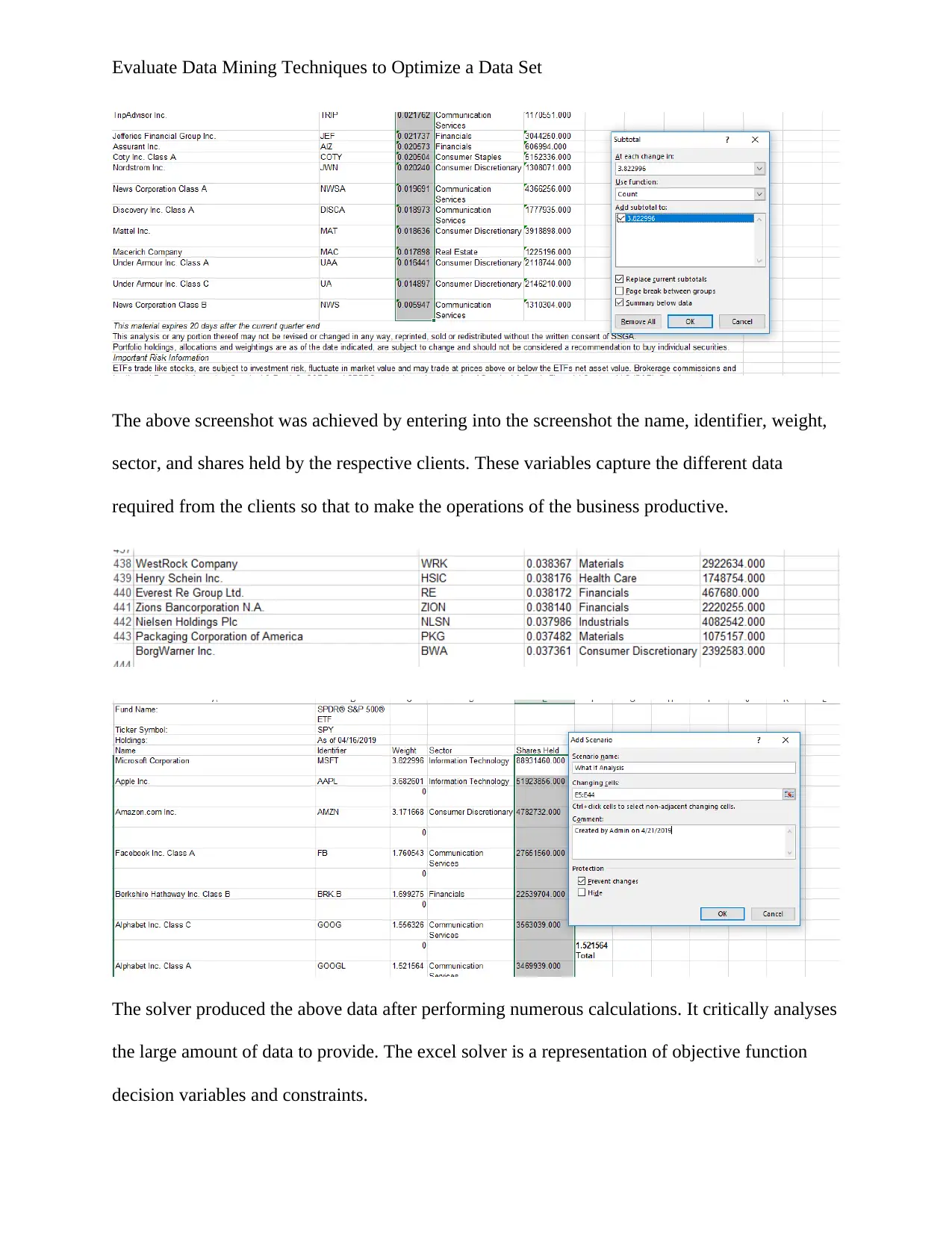
Evaluate Data Mining Techniques to Optimize a Data Set
The above screenshot was achieved by entering into the screenshot the name, identifier, weight,
sector, and shares held by the respective clients. These variables capture the different data
required from the clients so that to make the operations of the business productive.
The solver produced the above data after performing numerous calculations. It critically analyses
the large amount of data to provide. The excel solver is a representation of objective function
decision variables and constraints.
The above screenshot was achieved by entering into the screenshot the name, identifier, weight,
sector, and shares held by the respective clients. These variables capture the different data
required from the clients so that to make the operations of the business productive.
The solver produced the above data after performing numerous calculations. It critically analyses
the large amount of data to provide. The excel solver is a representation of objective function
decision variables and constraints.
⊘ This is a preview!⊘
Do you want full access?
Subscribe today to unlock all pages.

Trusted by 1+ million students worldwide
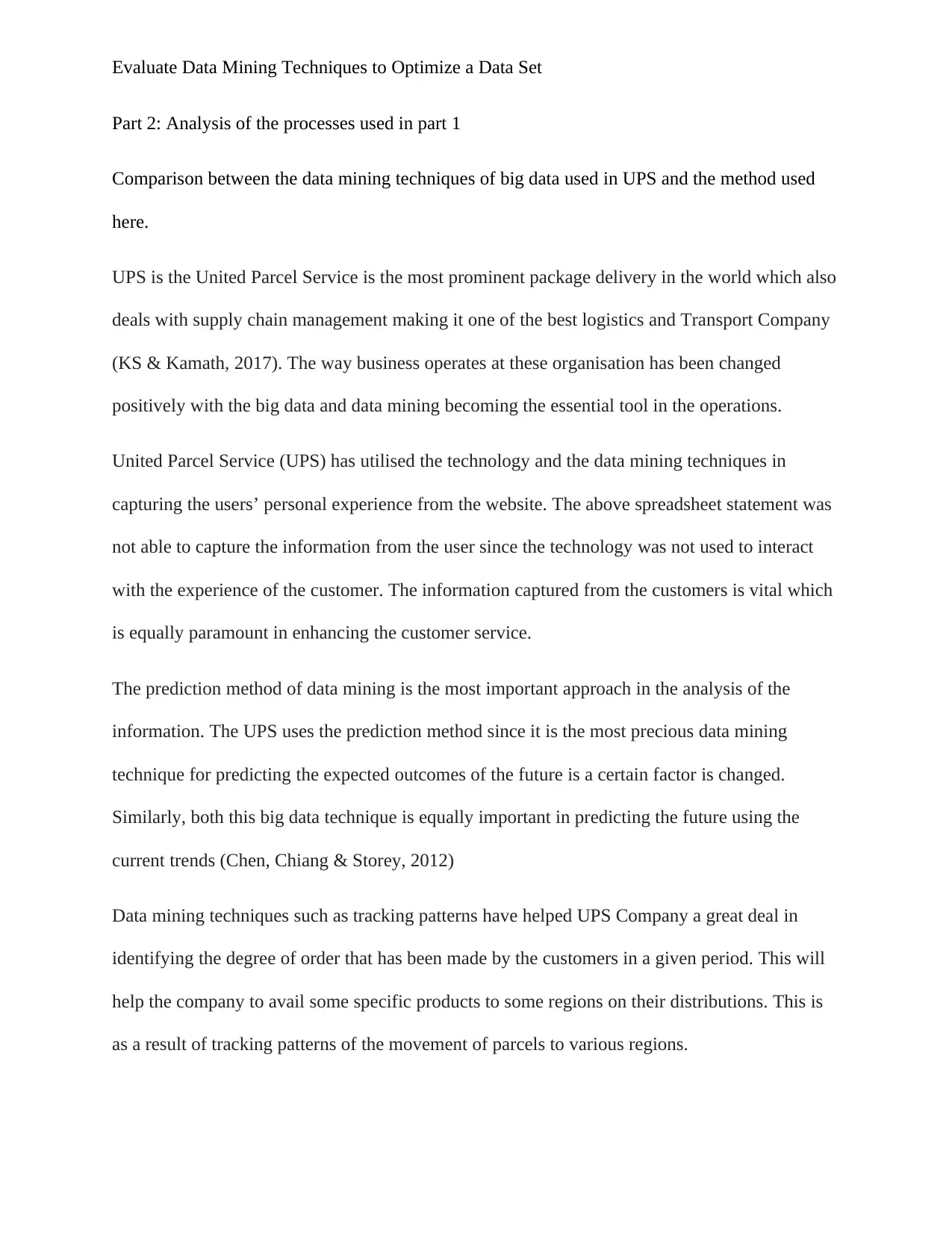
Evaluate Data Mining Techniques to Optimize a Data Set
Part 2: Analysis of the processes used in part 1
Comparison between the data mining techniques of big data used in UPS and the method used
here.
UPS is the United Parcel Service is the most prominent package delivery in the world which also
deals with supply chain management making it one of the best logistics and Transport Company
(KS & Kamath, 2017). The way business operates at these organisation has been changed
positively with the big data and data mining becoming the essential tool in the operations.
United Parcel Service (UPS) has utilised the technology and the data mining techniques in
capturing the users’ personal experience from the website. The above spreadsheet statement was
not able to capture the information from the user since the technology was not used to interact
with the experience of the customer. The information captured from the customers is vital which
is equally paramount in enhancing the customer service.
The prediction method of data mining is the most important approach in the analysis of the
information. The UPS uses the prediction method since it is the most precious data mining
technique for predicting the expected outcomes of the future is a certain factor is changed.
Similarly, both this big data technique is equally important in predicting the future using the
current trends (Chen, Chiang & Storey, 2012)
Data mining techniques such as tracking patterns have helped UPS Company a great deal in
identifying the degree of order that has been made by the customers in a given period. This will
help the company to avail some specific products to some regions on their distributions. This is
as a result of tracking patterns of the movement of parcels to various regions.
Part 2: Analysis of the processes used in part 1
Comparison between the data mining techniques of big data used in UPS and the method used
here.
UPS is the United Parcel Service is the most prominent package delivery in the world which also
deals with supply chain management making it one of the best logistics and Transport Company
(KS & Kamath, 2017). The way business operates at these organisation has been changed
positively with the big data and data mining becoming the essential tool in the operations.
United Parcel Service (UPS) has utilised the technology and the data mining techniques in
capturing the users’ personal experience from the website. The above spreadsheet statement was
not able to capture the information from the user since the technology was not used to interact
with the experience of the customer. The information captured from the customers is vital which
is equally paramount in enhancing the customer service.
The prediction method of data mining is the most important approach in the analysis of the
information. The UPS uses the prediction method since it is the most precious data mining
technique for predicting the expected outcomes of the future is a certain factor is changed.
Similarly, both this big data technique is equally important in predicting the future using the
current trends (Chen, Chiang & Storey, 2012)
Data mining techniques such as tracking patterns have helped UPS Company a great deal in
identifying the degree of order that has been made by the customers in a given period. This will
help the company to avail some specific products to some regions on their distributions. This is
as a result of tracking patterns of the movement of parcels to various regions.
Paraphrase This Document
Need a fresh take? Get an instant paraphrase of this document with our AI Paraphraser
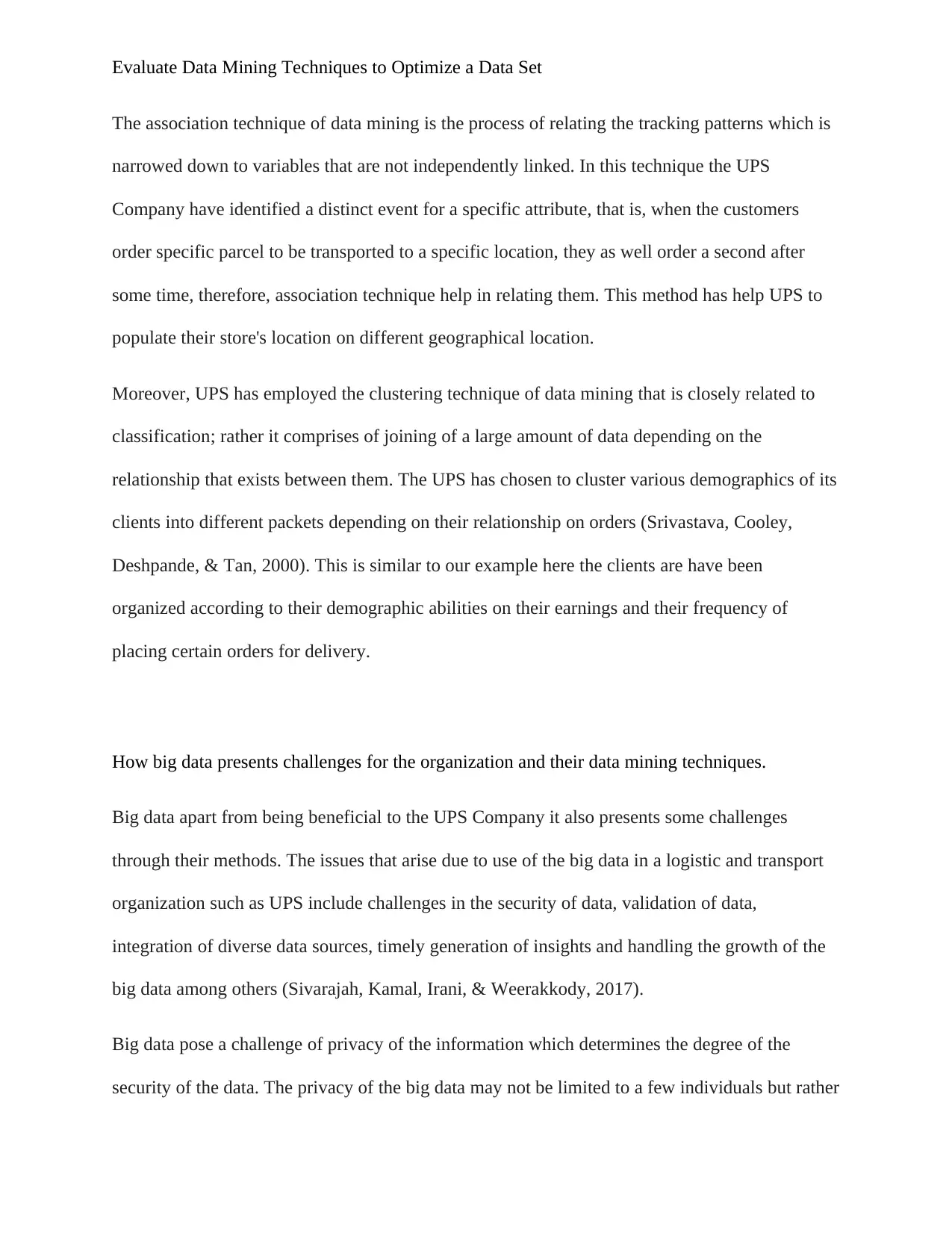
Evaluate Data Mining Techniques to Optimize a Data Set
The association technique of data mining is the process of relating the tracking patterns which is
narrowed down to variables that are not independently linked. In this technique the UPS
Company have identified a distinct event for a specific attribute, that is, when the customers
order specific parcel to be transported to a specific location, they as well order a second after
some time, therefore, association technique help in relating them. This method has help UPS to
populate their store's location on different geographical location.
Moreover, UPS has employed the clustering technique of data mining that is closely related to
classification; rather it comprises of joining of a large amount of data depending on the
relationship that exists between them. The UPS has chosen to cluster various demographics of its
clients into different packets depending on their relationship on orders (Srivastava, Cooley,
Deshpande, & Tan, 2000). This is similar to our example here the clients are have been
organized according to their demographic abilities on their earnings and their frequency of
placing certain orders for delivery.
How big data presents challenges for the organization and their data mining techniques.
Big data apart from being beneficial to the UPS Company it also presents some challenges
through their methods. The issues that arise due to use of the big data in a logistic and transport
organization such as UPS include challenges in the security of data, validation of data,
integration of diverse data sources, timely generation of insights and handling the growth of the
big data among others (Sivarajah, Kamal, Irani, & Weerakkody, 2017).
Big data pose a challenge of privacy of the information which determines the degree of the
security of the data. The privacy of the big data may not be limited to a few individuals but rather
The association technique of data mining is the process of relating the tracking patterns which is
narrowed down to variables that are not independently linked. In this technique the UPS
Company have identified a distinct event for a specific attribute, that is, when the customers
order specific parcel to be transported to a specific location, they as well order a second after
some time, therefore, association technique help in relating them. This method has help UPS to
populate their store's location on different geographical location.
Moreover, UPS has employed the clustering technique of data mining that is closely related to
classification; rather it comprises of joining of a large amount of data depending on the
relationship that exists between them. The UPS has chosen to cluster various demographics of its
clients into different packets depending on their relationship on orders (Srivastava, Cooley,
Deshpande, & Tan, 2000). This is similar to our example here the clients are have been
organized according to their demographic abilities on their earnings and their frequency of
placing certain orders for delivery.
How big data presents challenges for the organization and their data mining techniques.
Big data apart from being beneficial to the UPS Company it also presents some challenges
through their methods. The issues that arise due to use of the big data in a logistic and transport
organization such as UPS include challenges in the security of data, validation of data,
integration of diverse data sources, timely generation of insights and handling the growth of the
big data among others (Sivarajah, Kamal, Irani, & Weerakkody, 2017).
Big data pose a challenge of privacy of the information which determines the degree of the
security of the data. The privacy of the big data may not be limited to a few individuals but rather
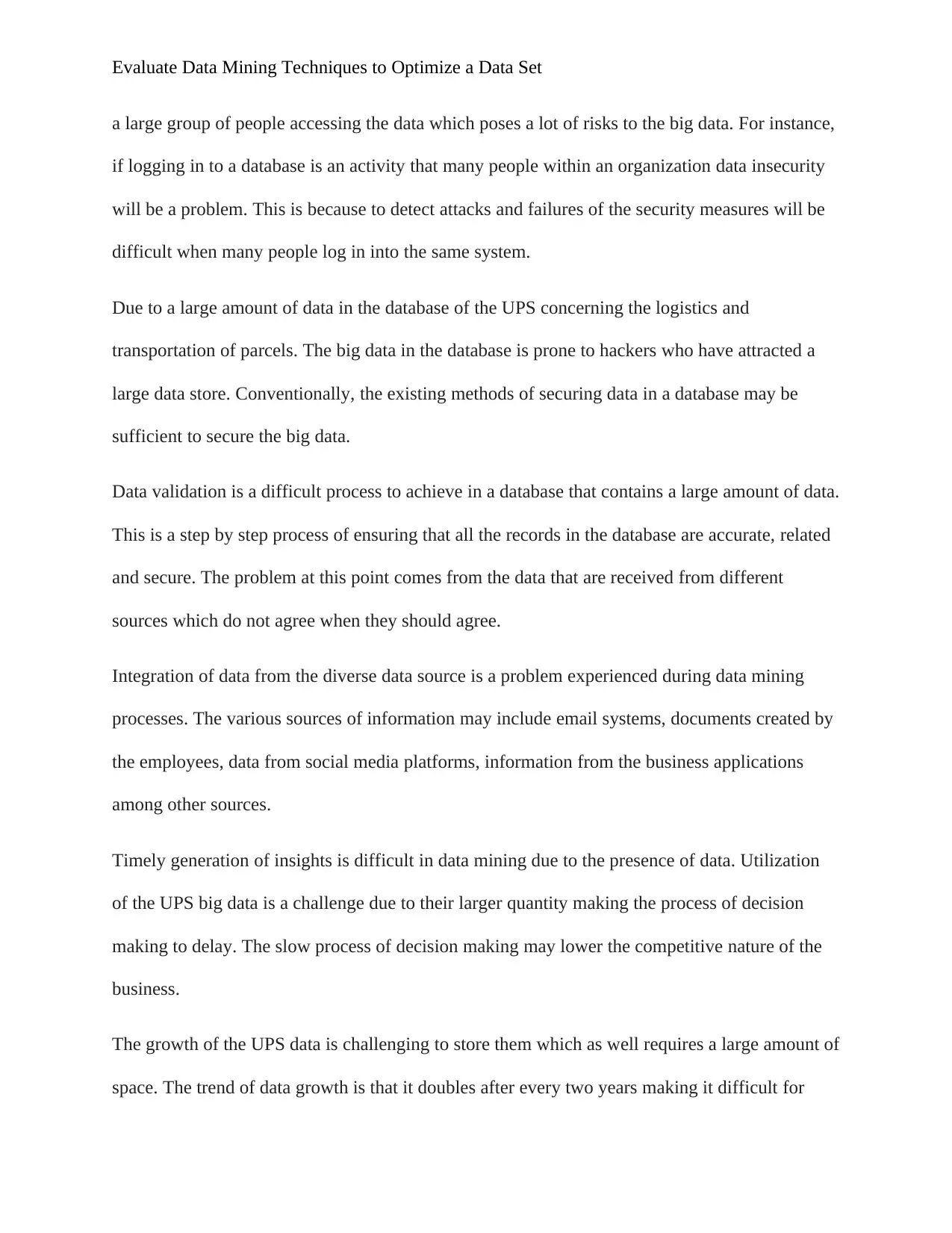
Evaluate Data Mining Techniques to Optimize a Data Set
a large group of people accessing the data which poses a lot of risks to the big data. For instance,
if logging in to a database is an activity that many people within an organization data insecurity
will be a problem. This is because to detect attacks and failures of the security measures will be
difficult when many people log in into the same system.
Due to a large amount of data in the database of the UPS concerning the logistics and
transportation of parcels. The big data in the database is prone to hackers who have attracted a
large data store. Conventionally, the existing methods of securing data in a database may be
sufficient to secure the big data.
Data validation is a difficult process to achieve in a database that contains a large amount of data.
This is a step by step process of ensuring that all the records in the database are accurate, related
and secure. The problem at this point comes from the data that are received from different
sources which do not agree when they should agree.
Integration of data from the diverse data source is a problem experienced during data mining
processes. The various sources of information may include email systems, documents created by
the employees, data from social media platforms, information from the business applications
among other sources.
Timely generation of insights is difficult in data mining due to the presence of data. Utilization
of the UPS big data is a challenge due to their larger quantity making the process of decision
making to delay. The slow process of decision making may lower the competitive nature of the
business.
The growth of the UPS data is challenging to store them which as well requires a large amount of
space. The trend of data growth is that it doubles after every two years making it difficult for
a large group of people accessing the data which poses a lot of risks to the big data. For instance,
if logging in to a database is an activity that many people within an organization data insecurity
will be a problem. This is because to detect attacks and failures of the security measures will be
difficult when many people log in into the same system.
Due to a large amount of data in the database of the UPS concerning the logistics and
transportation of parcels. The big data in the database is prone to hackers who have attracted a
large data store. Conventionally, the existing methods of securing data in a database may be
sufficient to secure the big data.
Data validation is a difficult process to achieve in a database that contains a large amount of data.
This is a step by step process of ensuring that all the records in the database are accurate, related
and secure. The problem at this point comes from the data that are received from different
sources which do not agree when they should agree.
Integration of data from the diverse data source is a problem experienced during data mining
processes. The various sources of information may include email systems, documents created by
the employees, data from social media platforms, information from the business applications
among other sources.
Timely generation of insights is difficult in data mining due to the presence of data. Utilization
of the UPS big data is a challenge due to their larger quantity making the process of decision
making to delay. The slow process of decision making may lower the competitive nature of the
business.
The growth of the UPS data is challenging to store them which as well requires a large amount of
space. The trend of data growth is that it doubles after every two years making it difficult for
⊘ This is a preview!⊘
Do you want full access?
Subscribe today to unlock all pages.

Trusted by 1+ million students worldwide
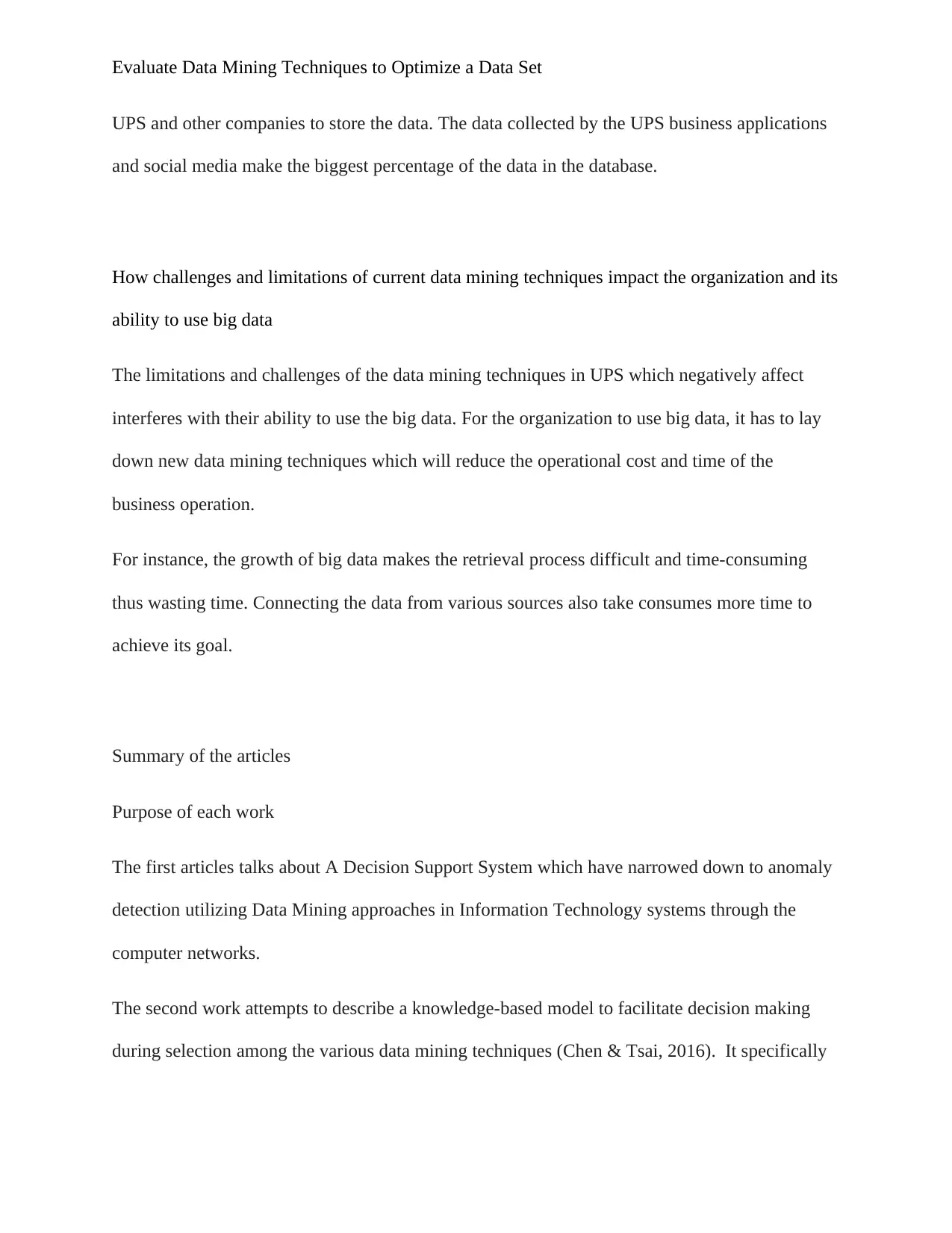
Evaluate Data Mining Techniques to Optimize a Data Set
UPS and other companies to store the data. The data collected by the UPS business applications
and social media make the biggest percentage of the data in the database.
How challenges and limitations of current data mining techniques impact the organization and its
ability to use big data
The limitations and challenges of the data mining techniques in UPS which negatively affect
interferes with their ability to use the big data. For the organization to use big data, it has to lay
down new data mining techniques which will reduce the operational cost and time of the
business operation.
For instance, the growth of big data makes the retrieval process difficult and time-consuming
thus wasting time. Connecting the data from various sources also take consumes more time to
achieve its goal.
Summary of the articles
Purpose of each work
The first articles talks about A Decision Support System which have narrowed down to anomaly
detection utilizing Data Mining approaches in Information Technology systems through the
computer networks.
The second work attempts to describe a knowledge-based model to facilitate decision making
during selection among the various data mining techniques (Chen & Tsai, 2016). It specifically
UPS and other companies to store the data. The data collected by the UPS business applications
and social media make the biggest percentage of the data in the database.
How challenges and limitations of current data mining techniques impact the organization and its
ability to use big data
The limitations and challenges of the data mining techniques in UPS which negatively affect
interferes with their ability to use the big data. For the organization to use big data, it has to lay
down new data mining techniques which will reduce the operational cost and time of the
business operation.
For instance, the growth of big data makes the retrieval process difficult and time-consuming
thus wasting time. Connecting the data from various sources also take consumes more time to
achieve its goal.
Summary of the articles
Purpose of each work
The first articles talks about A Decision Support System which have narrowed down to anomaly
detection utilizing Data Mining approaches in Information Technology systems through the
computer networks.
The second work attempts to describe a knowledge-based model to facilitate decision making
during selection among the various data mining techniques (Chen & Tsai, 2016). It specifically
Paraphrase This Document
Need a fresh take? Get an instant paraphrase of this document with our AI Paraphraser
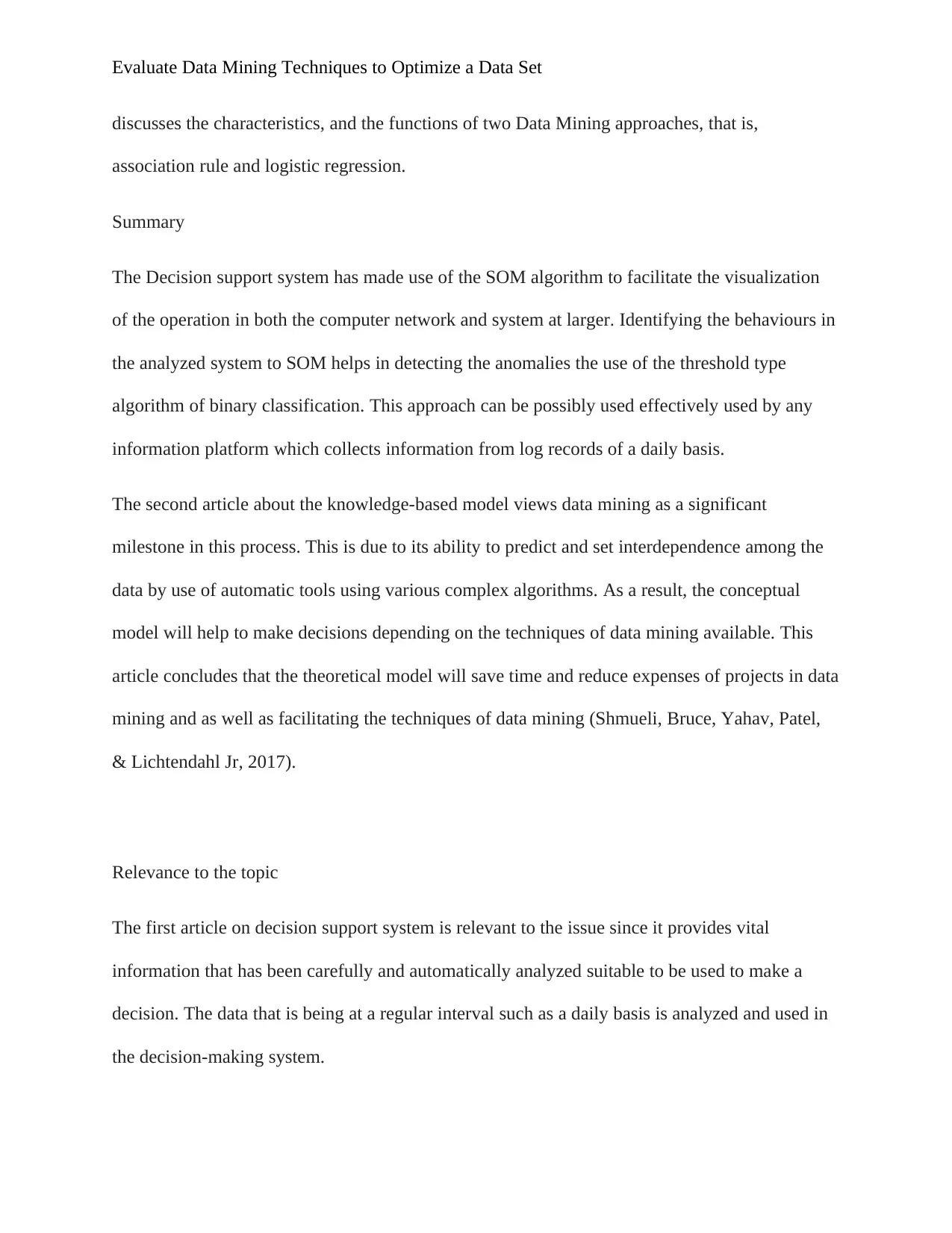
Evaluate Data Mining Techniques to Optimize a Data Set
discusses the characteristics, and the functions of two Data Mining approaches, that is,
association rule and logistic regression.
Summary
The Decision support system has made use of the SOM algorithm to facilitate the visualization
of the operation in both the computer network and system at larger. Identifying the behaviours in
the analyzed system to SOM helps in detecting the anomalies the use of the threshold type
algorithm of binary classification. This approach can be possibly used effectively used by any
information platform which collects information from log records of a daily basis.
The second article about the knowledge-based model views data mining as a significant
milestone in this process. This is due to its ability to predict and set interdependence among the
data by use of automatic tools using various complex algorithms. As a result, the conceptual
model will help to make decisions depending on the techniques of data mining available. This
article concludes that the theoretical model will save time and reduce expenses of projects in data
mining and as well as facilitating the techniques of data mining (Shmueli, Bruce, Yahav, Patel,
& Lichtendahl Jr, 2017).
Relevance to the topic
The first article on decision support system is relevant to the issue since it provides vital
information that has been carefully and automatically analyzed suitable to be used to make a
decision. The data that is being at a regular interval such as a daily basis is analyzed and used in
the decision-making system.
discusses the characteristics, and the functions of two Data Mining approaches, that is,
association rule and logistic regression.
Summary
The Decision support system has made use of the SOM algorithm to facilitate the visualization
of the operation in both the computer network and system at larger. Identifying the behaviours in
the analyzed system to SOM helps in detecting the anomalies the use of the threshold type
algorithm of binary classification. This approach can be possibly used effectively used by any
information platform which collects information from log records of a daily basis.
The second article about the knowledge-based model views data mining as a significant
milestone in this process. This is due to its ability to predict and set interdependence among the
data by use of automatic tools using various complex algorithms. As a result, the conceptual
model will help to make decisions depending on the techniques of data mining available. This
article concludes that the theoretical model will save time and reduce expenses of projects in data
mining and as well as facilitating the techniques of data mining (Shmueli, Bruce, Yahav, Patel,
& Lichtendahl Jr, 2017).
Relevance to the topic
The first article on decision support system is relevant to the issue since it provides vital
information that has been carefully and automatically analyzed suitable to be used to make a
decision. The data that is being at a regular interval such as a daily basis is analyzed and used in
the decision-making system.

Evaluate Data Mining Techniques to Optimize a Data Set
The knowledge-based system is relevant to the topic since it avails the information from the
present and the past which is more useful in decision making. This model receives its data from
the data stores that contain a large amount of information collected from different areas. This
data describes the organization.
The knowledge-based system is relevant to the topic since it avails the information from the
present and the past which is more useful in decision making. This model receives its data from
the data stores that contain a large amount of information collected from different areas. This
data describes the organization.
⊘ This is a preview!⊘
Do you want full access?
Subscribe today to unlock all pages.

Trusted by 1+ million students worldwide
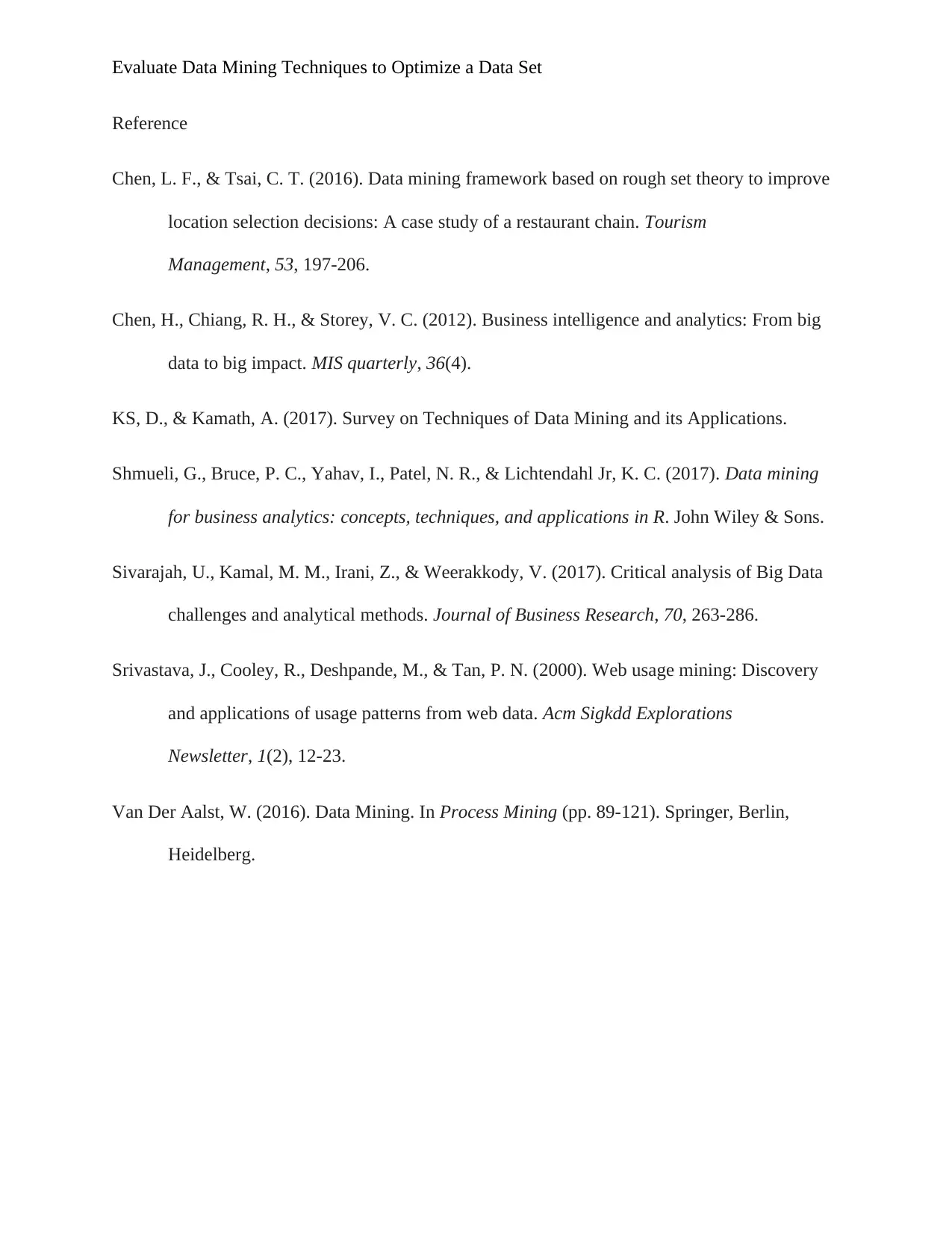
Evaluate Data Mining Techniques to Optimize a Data Set
Reference
Chen, L. F., & Tsai, C. T. (2016). Data mining framework based on rough set theory to improve
location selection decisions: A case study of a restaurant chain. Tourism
Management, 53, 197-206.
Chen, H., Chiang, R. H., & Storey, V. C. (2012). Business intelligence and analytics: From big
data to big impact. MIS quarterly, 36(4).
KS, D., & Kamath, A. (2017). Survey on Techniques of Data Mining and its Applications.
Shmueli, G., Bruce, P. C., Yahav, I., Patel, N. R., & Lichtendahl Jr, K. C. (2017). Data mining
for business analytics: concepts, techniques, and applications in R. John Wiley & Sons.
Sivarajah, U., Kamal, M. M., Irani, Z., & Weerakkody, V. (2017). Critical analysis of Big Data
challenges and analytical methods. Journal of Business Research, 70, 263-286.
Srivastava, J., Cooley, R., Deshpande, M., & Tan, P. N. (2000). Web usage mining: Discovery
and applications of usage patterns from web data. Acm Sigkdd Explorations
Newsletter, 1(2), 12-23.
Van Der Aalst, W. (2016). Data Mining. In Process Mining (pp. 89-121). Springer, Berlin,
Heidelberg.
Reference
Chen, L. F., & Tsai, C. T. (2016). Data mining framework based on rough set theory to improve
location selection decisions: A case study of a restaurant chain. Tourism
Management, 53, 197-206.
Chen, H., Chiang, R. H., & Storey, V. C. (2012). Business intelligence and analytics: From big
data to big impact. MIS quarterly, 36(4).
KS, D., & Kamath, A. (2017). Survey on Techniques of Data Mining and its Applications.
Shmueli, G., Bruce, P. C., Yahav, I., Patel, N. R., & Lichtendahl Jr, K. C. (2017). Data mining
for business analytics: concepts, techniques, and applications in R. John Wiley & Sons.
Sivarajah, U., Kamal, M. M., Irani, Z., & Weerakkody, V. (2017). Critical analysis of Big Data
challenges and analytical methods. Journal of Business Research, 70, 263-286.
Srivastava, J., Cooley, R., Deshpande, M., & Tan, P. N. (2000). Web usage mining: Discovery
and applications of usage patterns from web data. Acm Sigkdd Explorations
Newsletter, 1(2), 12-23.
Van Der Aalst, W. (2016). Data Mining. In Process Mining (pp. 89-121). Springer, Berlin,
Heidelberg.
1 out of 10
Related Documents
Your All-in-One AI-Powered Toolkit for Academic Success.
+13062052269
info@desklib.com
Available 24*7 on WhatsApp / Email
![[object Object]](/_next/static/media/star-bottom.7253800d.svg)
Unlock your academic potential
Copyright © 2020–2025 A2Z Services. All Rights Reserved. Developed and managed by ZUCOL.





